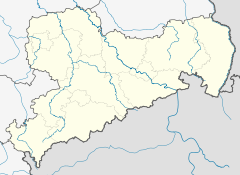
Leipzig is the most populous city in the German state of Saxony. Leipzig's population of 624,689 inhabitants as of 2022 places the city as Germany's eighth most populous, as well as the second most populous city in the area of the former East Germany after (East) Berlin. Together with Halle (Saale), the city forms the polycentric Leipzig-Halle Conurbation. Between the two cities lies Leipzig/Halle Airport.

The Berlin U-Bahn is a rapid transit system in Berlin, the capital and largest city of Germany, and a major part of the city's public transport system. Together with the S-Bahn, a network of suburban train lines, and a tram network that operates mostly in the eastern parts of the city, it serves as the main means of transport in the capital.
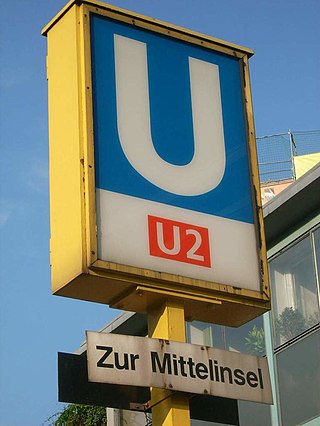
U2 is a line of the Berlin U-Bahn. The U2 line starts at Pankow S-Bahn station, runs through the eastern city centre (Alexanderplatz) to Potsdamer Platz, the western city centre and finally to the Ruhleben terminal station.

The U4 is a line of the Berlin U-Bahn in Germany, the shortest in Berlin's U-Bahn system with a length of 2.86 kilometres (1.78 mi). It serves five stations, with only the two termini being step-free. Opened in 1910, it is the only subway line in Berlin to have never been extended and the only one to have no night service on weekends.

U6 is a Berlin U-Bahn line, 19.9 km (12.4 mi) long line with 29 stations. It runs in a north-south direction from the Berlin locality of Tegel in the north via Friedrichstraße to Mariendorf, a locality in the southern part of the city. It is a so-called large profile ("Großprofil") line.
The U7 is a rail line on the Berlin U-Bahn. It runs completely underground for a length of 31.8 kilometres (19.8 mi) through 40 stations and connects Spandau, via Neukölln, to Gropiusstadt and Rudow. The line was originally the south-eastern branch of the Nord-Süd-Bahn (U6) that ran between the branching point at Belle-Alliance-Straße (Mehringdamm) and Grenzallee; however, in the 1960s, this stretch was separated from the rest of the line and extended at each end to form a new line. As of 2007, the U7 is Berlin's longest underground line, both in terms of absolute length and total travel time, and one of the longest (entire) subterranean lines in Europe.
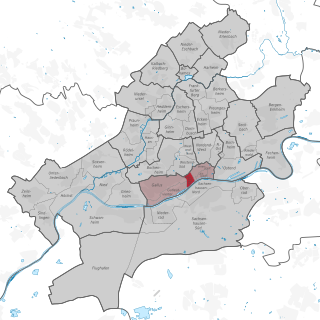
The Bahnhofsviertel is a quarter of Frankfurt am Main, Germany. It is part of the Ortsbezirk Innenstadt I.

Wilhelm Leuschner was a trade unionist and Social Democratic politician. An early opponent of Nazism, he organized underground resistance in the labour movement. As a result of involvement with the assassination attempt on Hitler in 1944, Leuschner was executed.

Dresden Hauptbahnhof is the largest passenger station in the Saxon capital of Dresden. In 1898, it replaced the Böhmischen Bahnhof of the former Saxon-Bohemian State Railway, and was designed with its formal layout as the central station of the city. The combination of a station building on an island between the tracks and a terminal station on two different levels is unique. The building is notable for its train-sheds, which are roofed with Teflon-coated glass fibre membranes. This translucent roof design, installed during the comprehensive restoration of the station at the beginning of the 21st century, allows more daylight to reach the concourses than was previously possible.

The Cologne Stadtbahn is a light rail system in the German city of Cologne, including several surrounding cities of the Cologne Bonn Region. The term Stadtbahn denotes a system that encompasses elements of trams as well as an underground railway network (U-Bahn) and interurban rail, even including three lines that are licensed as heavy rail and used by freight trains as well as Stadtbahn vehicles. Two of these lines connect the Cologne Stadtbahn to the Bonn Stadtbahn. These lines are jointly operated by both cities' transport authorities, resulting in both systems and the lines connecting them sometimes collectively referred to as Stadtbahn Rhein-Sieg.

The Anhalter Bahnhof is a former railway terminus in Berlin, Germany, approximately 600 m (2,000 ft) southeast of Potsdamer Platz. Once one of Berlin's most important railway stations, it was severely damaged in World War II, and finally closed for traffic in 1952, when the GDR-owned Deutsche Reichsbahn rerouted all railway traffic between Berlin and places in the GDR avoiding the West Berlin area. The station's name lives on in the Berlin S-Bahn station of the same name, opened in October 1939 as part of the North-South S-Bahn link.

Leipzig Hauptbahnhof is the central railway terminus in Leipzig, Germany, in the district Mitte. At 83,460 square metres (898,400 sq ft), it is Europe's largest railway station measured by floor area. It has 19 overground platforms housed in six iron train sheds, a multi-level concourse with towering stone arches, and a 298 metres (978 ft) long facade at the northeastern section of the Inner City Ring Road. The two Leipzig City Tunnel platforms were inaugurated in December 2013.

Berlin Potsdamer Platz is a railway station in Berlin. It is completely underground and situated under Potsdamer Platz in central Berlin. Regional and S-Bahn services call at the station, and it is also served by U-Bahn line U2.

The City Tunnel is a twin-bore railway tunnel for the city-centre S-Bahn in Leipzig. It links Leipzig Hauptbahnhof with the central Markt station, Wilhelm-Leuschner-Platz station and Bayerischer Bahnhof.

S-Bahn Mitteldeutschland represents an enlargement of the previous Leipzig-Halle S-Bahn. It is an electric rail public transit system operating in the metropolitan area of Leipzig-Halle, Germany. This S-Bahn network developed from two separate S-Bahn networks of Halle (Saale) and Leipzig, which were established separately in 1969 and then linked in 2004. With the opening of the Leipzig City Tunnel on 15 December 2013 as a new artery, the network was extended to the federal states of Thuringia and Brandenburg. The locomotive-hauled double-decker trains had been replaced by electric multiple unit Bombardier Talent 2 trains.
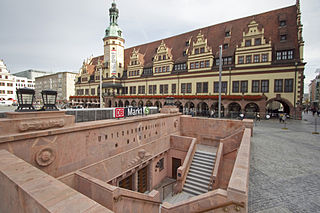
Leipzig Markt is a central railway station in the city of Leipzig, Germany. It was built as part of the Leipzig City Tunnel project and opened on 15 December 2013, enabling passengers to travel directly by rail from Leipzig Hauptbahnhof to the city centre.

The Berlin U-Bahn originated in 1880 with Werner Siemens' idea to build an urban railway in Berlin. During the nine years after the German Empire was founded, the city's population grew by over one-third and traffic problems increased. In 1896, Siemens & Halske began to construct the first stretch of overhead railway. On 1 April 1897, the company began construction of an electric underground railway. The Berliner Verkehrs Aktiengesellschaft (BVG) was formed in 1928, and took over further construction and operation of the network. In 1938, the company was renamed Berlin Transport Company; the original acronym, however, remained. Since 1994, the BVG has been a public company.

The Inner City Ring Road in Leipzig in the district of Mitte is the ring road around Leipzig's city centre. It encloses the just 0.7 km² large area of the old town without the former Vorstadts.
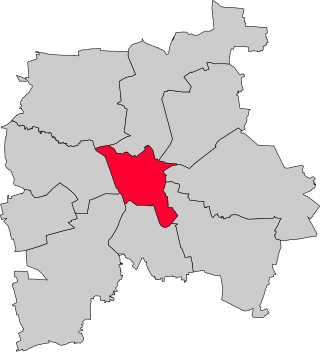
Leipzig-Mitte is one of 10 boroughs (Stadtbezirke) of Leipzig, located in the center of the city. It includes numerous architectural monuments. Most of them are located in the subdivision "Zentrum", which is sited inside the Inner City Ring Road and the Promenadenring:


